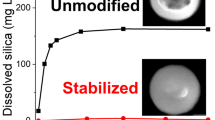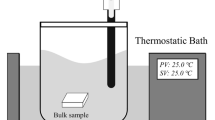Abstract
Although the occurrence of tetravalent actinide (An(IV)) silicates has been reported, little is known regarding the behavior of colloidal An(IV)-silicates in the environment. In this context, we prepared Th(IV)-silicate colloids and studied its dispersion stability as a function of important environmental factors, i.e., Si content, pH, electrolyte and fulvic acid (FA). Results indicated that the colloids were more stable at lower Th content and higher pH conditions. The aggregation of the colloids became kinetically faster with increasing ionic strength. Cations with higher valence triggered severer aggregation of Th(IV)-silicate colloids, while the same valence cations showed different coagulation abilities. As a result, the inhibition effect followed an order of Sr2+ > Ca2+ > Cs+ > Na+. In addition, the stability of Th(IV)-silicate colloids was improved significantly in the presence of FA. The dependence of the colloid stability on varied chemical conditions was well illustrated by the DLVO theory. The obtained results lay the foundation for elucidating the behavior and migration of An(IV)-silicate colloids in the environment.







Similar content being viewed by others
References
Deblonde GJP, Kersting AB, Zavarin M (2020) Open questions on the environmental chemistry of radionuclides. Commun Chem 3:167
Maher K, Bargar JR, Brown GE Jr (2013) Environmental speciation of actinides. Inorg Chem 52:3510–3532
Frazier SW, Kretzchmaer R, Kraemer SM (2005) Bacterial siderophores promote dissolution of UO2 under reducing conditions. Environ Sci Technol 39:5709–5715
Zänker H, Hennig C (2014) Colloid-borne forms of tetravalent actinides: a brief review. J Contam Hydrol 157:87–105
Geckeis H (2004) Colloid influence on the radionuclide migration from a nuclear waste repository. In: Giere, R., Stille, P. (Eds.), Energy, Waste and the Environment: Geochemical Perspective. Geological Society, London, Special Publications 236: 529–543
Panak PJ, Kim MA, Yun YI, Kim JI (2003) Interaction of actinides with aluminosilicate colloids in statu nascendi: part II: spectroscopic speciation of colloid-borne actinides(III). Colloids Surf A Physicochem Eng Asp 227:93–103
Bouby M, Geckeis H, Lützenkirchen J, Mihai S, Schäfer T (2011) Interaction of bentonite colloids with cs, Eu, Th and U in presence of humic acid: a flow field-flow fractionation study. Geochim Cosmochim Acta 75:3866–3880
Wang Y, Frutschi M, Suvorova E, Phrommavanh V, Descostes M, Osman A, Geipel G, Bernier-Latmani R (2013) Uranium(IV) mobility in a mining-impacted wetland. Goldschmidt Conference, Florence, Abstracts: 2464
Xu C, Santschi PH, Zhong JY, Hatcher PG, Francis AJ, Dodge CJ, Roberts KA, Hung CC, Honeyman BD (2008) Colloidal cutin-like substances cross-linked to siderophore decomposition products mobilizing plutonium from contaminated soils. Environ Sci Technol 42:8211–8217
Johnsson A, Odegaard-Jensen A, Skarnemark G, Pedersen K (2009) Leaching of spent nuclear fuel in the presence of siderophores. J Radioanal Nucl Chem 279:619–626
Pirlet V (2001) Overview of actinides (np, Pu, Am) and tc release from waste glasses: influence of solution composition. J Nucl Mater 298:47–54
Dietzel M (2000) Dissolution of silicates and the stability of polysilicic acid. Geochim Cosmochim Acta 64:3275–3281
Deditius APP, Pointeau V, Zhang JMM, Ewing RC (2012) Formation of nanoscale Th-coffinite. Am Mineral 97:681–693
Pointeau V, Deditius AP, Miserque F, Renock D, Becker U, Zhang J, Clavier N, Dacheux N, Poinssot C, Ewing RC (2009) Synthesis and characterization of coffinite. J Nucl Mater 393:449–458
Szenknect S, Costin DT, Clavier N, Mesbah A, Poinssot C, Vitorge P, Dacheux N (2013) From uranothorites to coffinite: a solid solution route to the thermodynamic properties of USiO4. Inorg Chem 52:6957–6968
Siever R (1972) Silicon-abundance in natural waters. In: Wedepohl, K.H., (Eds.), Handbook of Geochemistry. Springer: 14-I-1–14-I-6
Langmuir D (1997) Aqueous Environmental Geochemistry. Prentice-Hall Inc
Yusov AB, Garnov AY, Shilov VP, Tananaev IG, Grigor’ev MS, Krot NN (2000) Plutonium(IV) precipitation from alkaline solutions: II. Effect of anions on composition and properties of hydrated plutonium dioxide PuO2·xH2O. Radiochem 42:157–160
Zänker H, Weiss S, Hennig C, Brendler V, Ikeda-Ohno A (2016) Oxyhydroxy silicate colloids: a new type of waterborne actinide(IV) colloids. ChemistryOpen 5:174–182
Dreissig I, Weiss S, Hennig C, Bernhard G, Zänker H (2011) Formation of uranium(IV)-silica colloids at near-neutral pH. Geochim Cosmochim Acta 75:352–367
Hennig C, Weiss S, Banerjee D, Brendler E, Honkimäki V, Cuello G, Ikeda-Ohno A, Scheinost AC, Zänker H (2013) Solid-state properties and colloidal stability of thorium(IV)–silica nanoparticles. Geochim Cosmochim Acta 103:197–212
Husar R, Weiss S, Hennig C, Hubner R, Ikeda-Ohno A, Zanker H (2015) Formation of neptunium(IV)-silica colloids at near-neutral and slightly alkaline pH. Environ Sci Technol 49:665–671
Browman MG, Robinson RB, Reed GD (1989) Silica polymerization and other factors in iron control by sodium silicate and sodium hypochlorite additions. Environ Sci Technol 23:566–572
Panak PJ, Kim MD, Klenze R, Kim JI, Fanghanel T (2005) Complexation of cm(III) with aqueous silicic acid. Radiochim Acta 93:133–139
Wagner S, Gondikas A, Neubauer E, Hofmann T, von der Kammer F (2014) Spot the difference: engineered and natural nanoparticles in the environment-release, behavior, and fate. Angew Chem Int Ed Engl 53:12398–12419
Jensenf MP, Choppin GR (1996) Complexation of europium(III) by aqueous orthosilicic acid. Radiochim Acta 72:143–150
Zhang D, Wang Y, Heng J, Diao X, Zu G, Jin Q, Chen Z, Guo Z (2022) Stability of Eu(III)-silicate colloids: Effect of Eu content, pH, electrolyte and fulvic acid. J Hazard Mater 438:129363
Chen KL, Elimelech M (2006) Aggregation and deposition kinetics of fullerene (C60) nanoparticles. Langmuir 22:10994–11001
Zhang W, Crittenden J, Li K, Chen Y (2012) Attachment efficiency of nanoparticle aggregation in aqueous dispersions: modeling and experimental validation. Environ Sci Technol 46:7054–7062
Missana T, Adell A (2000) On the applicability of DLVO theory to the prediction of clay colloids stability. J Colloid Interface Sci 230:150–156
Ueno K, Inaba A, Kondoh M, Watanabe M (2008) Colloidal stability of bare and polymer-grafted silica nanoparticles in ionic liquids. Langmuir 24:5253–5259
Meier M, Ungerer J, Klinge M, Nirschl H (2018) Formation of porous silica nanoparticles at higher reaction kinetics. Powder Technol 339:801–808
Kosmulski M (2009) pH-dependent surface charging and points of zero charge. IV. Update and new approach. J Colloid Interface Sci 337:439–448
Sahai N (2002) Is silica really an anomalous oxide? Surface acidity and aqueous hydrolysis revisited. Environ Sci Technol 36:445–452
Yu C, Munoz-Carpena R, Gao B, Perez-Ovilla O (2013) Effects of ionic strength, particle size, flow rate, and vegetation type on colloid transport through a dense vegetation saturated soil system: experiments and modeling. J Hydrol 499:316–323
Sobecka DC, Higgins MJ (2002) Examination of three theories for mechanisms of cation-induced bioflocculation. Water Res 36:527–538
Li H, Wen Y, Cao A, Huang J, Zhou Q (2014) The influence of multivalent cations on the flocculation of activated sludge with different sludge retention times. Water Res 55:225–232
Li Q, Xie L, Jiang Y, Fortner JD, Yu K, Liao P, Liu C (2019) Formation and stability of NOM-Mn(III) colloids in aquatic environments. Water Res 149:190–201
Nowicki W, Nowicka G (1994) Verification of the Schulze-Hardy rule: a colloid chemistry experiment. J Chem Edu 71:624–626
Liu Z, Rios-Carvajal T, Andersson MP, Ceccato M, Stipp SLS, Hassenkam T (2019) Ion effects on molecular interaction between graphene oxide and organic molecules. Environ Sci Nano 6:2281–2291
Huynh KA, Chen KL (2011) Aggregation kinetics of citrate and polyvinylpyrrolidone coated silver nanoparticles in monovalent and divalent electrolyte solutions. Environ Sci Technol 45:5564–5571
Singh N, Tiwari E, Khandelwal N, Darbha GK (2019) Understanding the stability of nanoplastics in aqueous environments: effect of ionic strength, temperature, dissolved organic matter, clay, and heavy metals. Environ Sci Nano 6:2968–2976
Yang K, Xing B (2009) Adsorption of fulvic acid by carbon nanotubes from water. Environ Pollut 157:1095–1100
Acknowledgements
This work funded by the National Natural Science Foundation of China (Grant Nos. 21906074, 22176079, 12175094), the Natural Science Foundation of Gansu Province, China (Nos. 21JR7RA513, 22JR5RA480) and the Fundamental Research Funds for the Central Universities (lzujbky-2021-32, lzujbky-2022-sp05).
Author information
Authors and Affiliations
Corresponding authors
Ethics declarations
Conflict of interest
The authors declare that they have no known competing financial interests or personal relationships that could have appeared to influence the work reported in this paper.
Additional information
Publisher’s Note
Springer Nature remains neutral with regard to jurisdictional claims in published maps and institutional affiliations.
Rights and permissions
Springer Nature or its licensor (e.g. a society or other partner) holds exclusive rights to this article under a publishing agreement with the author(s) or other rightsholder(s); author self-archiving of the accepted manuscript version of this article is solely governed by the terms of such publishing agreement and applicable law.
About this article
Cite this article
Zhang, D., Diao, X., Wang, Y. et al. Effect of Si content, pH, electrolyte and fulvic acid on the stability of Th(IV)-silicate colloids. J Radioanal Nucl Chem 332, 1171–1180 (2023). https://doi.org/10.1007/s10967-022-08703-5
Received:
Accepted:
Published:
Issue Date:
DOI: https://doi.org/10.1007/s10967-022-08703-5




